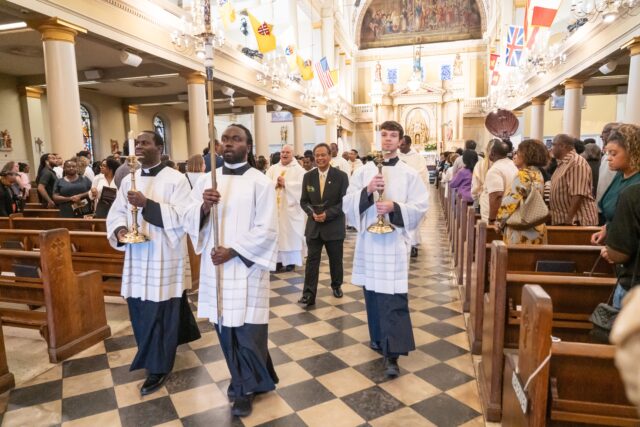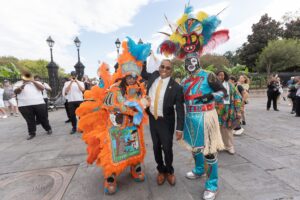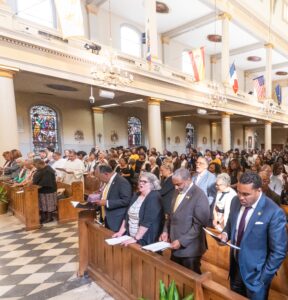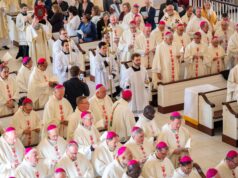
NEW ORLEANS — In a city renowned for its seemingly genetic ability to parade, party and partake, the 100th anniversary of Xavier University of Louisiana has focused on the gifts of faith, love and reading the signs of the times.
Xavier was established in 1925 by St. Katharine Drexel on the financial strength of the multimillion-dollar inheritance she received from her Philadelphia father’s banking estate,
Stories are legendary about how the socially conscious heiress — a slight but energetic nun who overcame the hostility and indifference of society and the church — established an amazing network of schools, churches and missions specifically for Blacks and Native Americans.
In reality, St. Katharine was almost a century before her time in demanding civil rights for the invisible and downtrodden, jump-starting the Catholic Church in the U.S. on the road toward racial integration.
The crowning jewel of St. Katharine’s educational system was Xavier University of Louisiana, the only Catholic institution of higher learning established exclusively for African-Americans in the Western Hemisphere. The university culminated its centennial year with a Mass at St. Louis Cathedral in New Orleans Oct. 1.
Renowned for its pharmacy and premed programs, Xavier remains a national leader in sending African-American graduates to medical school.
Just as it established a groundbreaking pharmacy program in 1927 to train African-Americans to work in underserved communities in rural Louisiana, Xavier now is embarking on its most ambitious project yet — a multiyear project that will culminate in the launch of Louisiana’s fourth medical school — in a partnership with Ochsner Health.
One of the overarching goals of the Xavier Ochsner College of Medicine, which is expected to complete its evaluation and accreditation process in two to three years, will be to increase the number of Black and other underrepresented medical professionals. Louisiana ranks third in the nation, per capita, in that underrepresentation.
“If you look at what Mother Katharine established at Xavier, it was a school that was expected to read the signs of the times,” Reynold Verret, who has served since 2015 as Xavier’s president, told OSV News. “She did not establish the school of pharmacy right away, but there was discernment that there was a need. Establishing a medical school is reading the signs of the times and where education is needed and where Xavier can contribute significantly.”

In 2019, in another partnership with Ochsner, Xavier established a physician assistant program as a way of expanding its cohort of licensed and highly skilled health care professionals.
Katharine Drexel’s story is mind-boggling, extending far beyond the millions of dollars she invested in establishing and supporting 65 schools, churches and centers in 21 states through her religious order, the Sisters of the Blessed Sacrament.
But in an age in which Americans obsess over Powerball lotteries and the stock market, the money Katharine Drexel gave away is a powerful and countercultural sign that, indeed, she was someone on a unique spiritual mission.
Consider this: When her father, Francis Drexel, died in 1885, the high-powered banker left behind a $15.5 million estate that was divided among his three daughters — Elizabeth, Catherine (Katharine’s birth name) and Louise. About $1.5 million went to several charities, leaving the girls to share in the income produced by $14 million – about $1,000 a day for each woman.
In current dollars, the estate would be worth about $250 million. Over the course of 60 years — up to her death in 1955 at age 96 — Mother Katharine spent about $20 million in support of her work, building schools and churches and paying the salaries of teachers in rural schools for Blacks and Indians.
Louise Drexel Morell, her younger sister, contributed millions more to similar causes. Elizabeth, the eldest sister, died in 1890 in premature childbirth, one year before Catherine formed the Sisters of the Blessed Sacrament for Indians and Negroes, in Bensalem, Pennsylvania, just outside Philadelphia.

Francis Drexel crafted his will carefully. His daughters controlled the income from the estate, and upon their deaths, the Drexel inheritance would flow to their children. Drexel did this to prevent his unmarried daughters from falling prey to “fortune hunters.”
Neither Catherine nor Louise, however, had children, and the will stipulated that if that were to happen, upon his daughters’ deaths, the money would be distributed to several religious orders and charities — the Society of Jesus, the Christian Brothers, the Religious of the Sacred Heart, a Lutheran hospital and others.
Drexel, of course, had no way of knowing that his “Kate” would enter religious life in 1889 and two years later found her order. Thus, after her death in 1955, the Sisters of the Blessed Sacrament no longer had the Drexel fortune available to support their ministries.
Norman Francis, Xavier’s president from 1968 to 2015, always considered Mother Katharine’s longevity, especially in light of a serious heart attack she suffered in 1935, to be a miracle.
“Xavier is a miracle not just for all that it has done but for the mere fact that it has survived and thrived,” Francis said before Katharine was canonized in 2000 by St. John Paul II. “If she had died at the normal age of 70, which at the time would have been a big age, Xavier would have struggled. (But) God allowed her to live until she was 96, and we had that interest available for many more years.”
Many believe Kate’s stepmother, Emma Bouvier, planted the seeds for her religious vocation.
Francis Drexel married Bouvier a few years after the death of his first wife, Hannah, who had died after giving birth to Kate in 1858. Twice a week, the Drexels distributed food, clothing and rent assistance from their family home in Philadelphia.
Kate made her social debut in Philadelphia in 1879, but her stepmother contracted cancer a short time later. Kate nursed her for the final three years of her life and came to realize that not even the Drexels’ immense fortune could do anything to prevent Emma’s death in 1883. Kate began to consider a religious vocation.
Kate still was reeling from the death of her father when she and her sisters went to Europe in 1886, with the hope of her regaining some physical vigor. The vacation climaxed in Rome in January 1887 when Pope Leo XIII received the Drexel sisters in a private audience. Kate told the pope about her inward pull toward the contemplative life, but she also described the plight of the Indians in North America.
“It has seemed to me more than once, Your Holiness, that I ought to aid them by my personal work among them as well, and if I enter an enclosed congregation, I might be abandoning those whom God wants me to help,” she told the pope. “Perhaps Your Holiness will designate a congregation that would give all its time and effort to the Indian missions.”
Pope Leo XIII replied with a question: “But why not be a missionary yourself, my child?”
Reaching the anteroom after the meeting, Kate broke down in tears, knowing she no longer had to wait. Her decision rocked Philadelphia social circles. The Philadelphia Public Ledger carried a banner headline: “Miss Drexel Enters a Catholic Convent – Gives Up Seven Million.”
In 1915, when Mother Katharine purchased an abandoned university building to open Xavier Preparatory School in New Orleans, vandals smashed every window.
In the late 1920s, when Mother Katharine found property in New Orleans for expanding Xavier University, she used a third party as a purchasing agent to keep the transaction from falling through. When the handsome campus was dedicated in October 1932, a priest gazed upon the expensive Indiana limestone buildings and remarked in Latin: “O vastum!” (“What a waste!”).
Blessed Katharine never heard the remark. The woman who had spent $656,000 for the land and new buildings watched the dedication ceremony from a third-floor window, far away from the dignitaries’ platform.
“Her response to The New York Times reporter who asked why she was spending so much money, especially on expensive stone for her buildings, was, ‘Do they not deserve the best?'” Verret said. “She had a deeply Christian notion of humanity — that basically, everyone is a child of God.”
Ronnie Owens, 72, a 1975 accounting graduate, recalled how he washed dishes and served food in the Xavier cafeteria during his last two years at Booker T. Washington High School nearby and then directed the storeroom inventory as a Xavier undergraduate in exchange for free tuition.
“Had it not been for me being a high school student working there, I’m going to say there was a 100% chance I wouldn’t have been at Xavier University,” Owens said.
Milton Granger, who was in charge of student affairs at Xavier at the time, saw the 18-year-old Owens in the cafeteria and told him to show up the following Saturday to take the SAT test. Owens loved math in high school.
“My SAT score was pretty high,” said Owens, who went on to become an administrative assistant under Ernest “Dutch” Morial, the city’s first Black mayor. “In the four years I went to Xavier for regular schooling, I didn’t have to pay one penny out of pocket.”
Dominique Bell, a 2009 pharmacy major and four-time Gulf Coast Athletic Conference Player of the Year in tennis, said her training allowed her to seamlessly advance in her career as a retail pharmacist and later as a clinical pharmacist in long-term care in Ridgeland, Mississippi, north of Jackson.
“Xavier is very selective in who they choose for those programs,” Bell said. “You have to have a certain GPA just to enter pharmacy school, and it’s the same with their ability to place all those (future) doctors into medical school. You are held to a high standard.”
“We educate where the need is,” Verret said. “I can assure you that someone down the line after me will read the signs of the times and say, ‘We don’t need this anymore. We need to move in this direction.'”








